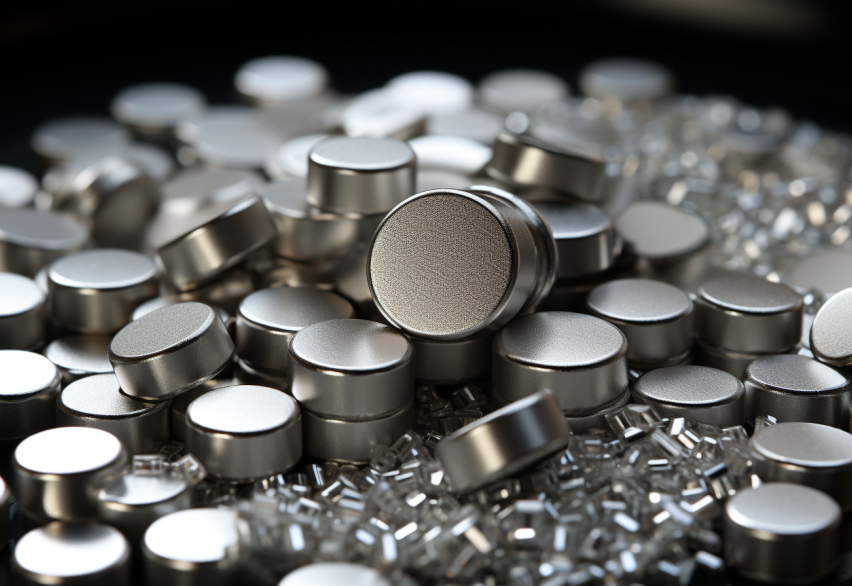Introduction
Chromium is a transition metal that is commonly used as an evaporation material for thin-film coatings. The use of chromium pellets as evaporation materials in thin-film coating is based on their high melting and boiling points, good thermal conductivity, and excellent adhesion to various substrates. This article introduces chromium pellets as an evaporation material for thin-film coatings, covering their production, purification, shaping, deposition techniques, factors affecting coating quality, applications, advantages, and challenges, emphasizing their significance in the production of high-performance devices and coatings.
Production and Purification
Reduction: The process typically begins with the reduction of chromite ore using carbon as a reducing agent. This reduction reaction occurs at high temperatures, resulting in the formation of crude chromium.
Purification: After that, the crude chromium undergoes a purification process to remove impurities and further refine the material. Different techniques, such as leaching, precipitation, and distillation, may be employed during this purification stage. Leaching involves dissolving the crude chromium in suitable solvents to separate impurities selectively. Precipitation methods can be used to isolate specific compounds or impurities from the solution through chemical reactions. Distillation, on the other hand, utilizes differences in boiling points to separate volatile impurities from the chromium.
Shaping: It is then shaped into pellets of specific sizes and shapes required for thin-film coating processes. The shaping process can involve pressing the chromium material under high pressure or using specialized equipment to form precise shapes.
Deposition Techniques
After reduction, purification, and shaping, the next step is to deposit these chromium pellets onto substrates to form a thin film. This deposition process is typically accomplished through two main techniques: physical vapor deposition (PVD) and chemical vapor deposition (CVD).
In Physical Vapor Deposition (PVD), chromium pellets are heated to their melting point inside a vacuum chamber. As they undergo melting, they transition into vapor and subsequently condense onto the substrate, resulting in the formation of a thin film.
On the other hand, Chemical Vapor Deposition (CVD) follows a different approach. It entails introducing chromium-containing precursors into a deposition chamber. Under specific conditions, these precursors undergo chemical reactions leading to the creation of chromium films on the substrate.
PVD and CVD techniques present distinct advantages depending on the specific demands of an application. PVD provides meticulous regulation over film thickness and deposition rate, making it ideal for situations where precise thickness control is paramount. Conversely, CVD allows for the application of chromium films on substrates with intricate shapes and facilitates conformal coatings. The selection between these deposition methods relies on factors like desired film properties, substrate material, coating uniformity requirements, and cost considerations.
Related Reading: Table Comparison: Physical Vapor Deposition Vs. Chemical Vapor Deposition
Factors Affecting Coating Quality
The performance and quality of thin film coatings depend on several factors, including the purity of the source material, deposition process parameters, and substrate material.
Purity: The purity of the chromium target used to generate the chromium film is critical to obtaining a high-quality coating. Even tiny impurities, such as oxygen, carbon, nitrogen, hydrogen, etc., can adversely affect the performance and quality of chrome film coatings, such as adhesion, electrical conductivity, optical properties, and mechanical strength.
Process parameters: Careful control of deposition process parameters such as temperature, pressure, and deposition rate are critical to ensure uniformity and adhesion of the chromium film to the substrate. Improper control of these parameters may affect film growth, density, microstructure, and thickness, among others.
Substrate material: The selection of the substrate material plays a pivotal role in determining the performance of the chromium film coating. Commonly used substrates for chromium film coatings include glass, silicon, metals such as stainless steel, aluminum, and titanium, as well as ceramics like aluminum and silicon carbide. Each substrate material exhibits exceptional adhesion and stress characteristics, which directly impact the overall quality and performance of the coating. Thus, carefully considering the substrate material is crucial to ensure optimal adhesion and stress management in the final chromium film coating.
Applications of Chromium Pellets in Evaporation Coating
Chromium pellets are extensively employed in various industries, including the production of semiconductor devices, solar cells, and optical coatings. In the semiconductor industry, chromium serves as a crucial barrier layer between the aluminum and silicon layers of the device. By acting as a diffusion barrier, it prevents the undesired diffusion of atoms between these layers, thereby enhancing device performance and reliability.

In the realm of solar cell production, chromium finds its utility as a back contact material. Its electrical conductivity and resistance to corrosion make it an ideal choice for this application. The chromium back contact ensures efficient electron transfer and contributes to the overall stability and durability of the solar cell.
In the field of optical coatings, chromium exhibits its versatility. Depending on the desired optical properties of the coating, chromium can serve as either a reflective or absorptive layer. When utilized as a reflective layer, chromium facilitates effective light reflection, making it suitable for applications like mirrors and anti-reflective coatings. Conversely, as an absorptive layer, chromium absorbs particular wavelengths of light, enabling the customization of optical characteristics such as color and opacity in filters and other optical devices.
Advantages and Challenges of Using Chromium Pellets
Chromium surpasses commonly used evaporation materials, such as gold and aluminum thin film coatings. Its high melting and boiling points make it ideal for high-temperature applications. Additionally, chromium exhibits strong adhesion to a variety of substrates, offering versatility in coating applications. Furthermore, its favorable optical properties allow precise control over light transmission and reflection, enabling the creation of customized optical coatings.
However, utilizing chromium particles for thin film coatings presents challenges. The production of high-purity chromium pellets requires meticulous maintenance of material purity. Proper handling and storage procedures are crucial due to the potential health hazards associated with chromium. Moreover, the deposition process is complex and demands specialized equipment and expertise to achieve desired results in terms of uniformity, adhesion, and film properties.
Despite these challenges, chromium remains a valuable choice for thin film coatings when managed with care and expertise, thanks to its exceptional advantages such as high-temperature suitability, strong adhesion, and favorable optical properties.
Conclusion
In conclusion, chromium pellets are an important evaporation material for thin-film coatings, offering unique properties that make them suitable for a wide range of applications. As technology continues to advance and new applications for thin-film coatings emerge, the role of chromium pellets in this field is likely to expand, making it an essential material in the production of high-performance devices and coatings.
If you’re looking for a reliable source of high-quality chromium pellets or other thin-film coating materials, Stanford Advanced Materials is your best choice. As a global supplier of sputtering targets and evaporation materials, we offer a wide range of tailored products that are made from top-quality materials and manufactured to the highest standards, ensuring optimal performance and reliability in any coating process. With our commitment to providing comprehensive solutions and exceptional service, we are dedicated to helping you achieve your thin-film coating goals. Send us an inquiry to learn more about how we can help with your next coating project.




